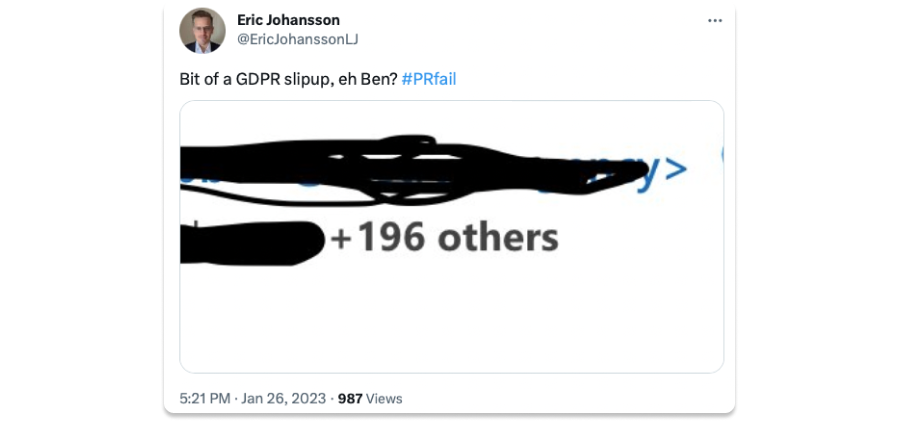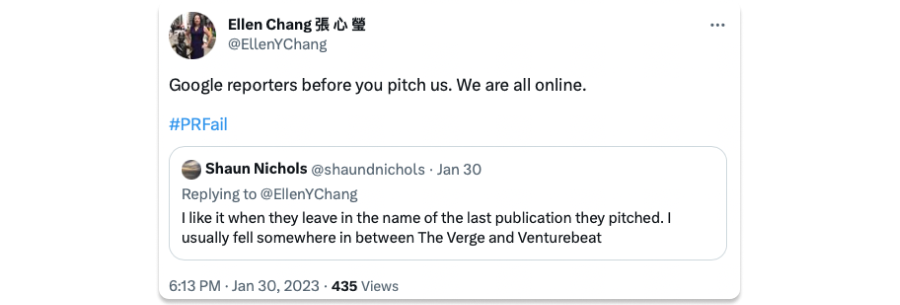Have you thought of your valentine today? No, not the one at home, but the one you woo every day at work: the media!
On this Valentine’s Day, we’re thinking about how media relations can be very similar to dating. You’re hungry for their attention, you want them to remember you, and you wait with bated breath for their next message.
As with any relationship, though, our relationships with journalists can swing from love to hate if we don’t hold up our end of the bargain.
Here are 7 relationship killers that journalists have shared, followed by tips from experienced PR pros on how to avoid these costly mistakes.
👉 Relationship killer #1: Letting things get stale
What it looks like:

How to keep it fresh:
Keep your news timely, even if that means you need to rewrite your last press release with a fresh spin. Journalists live and breathe on the latest and greatest news you can deliver them.
💭 From Sophie Rhone, Senior Public Relations Consultant:
“If something was published a week ago or more, it’s no longer news. Take the time to cut your losses and create something fresh and topical. Journalists don’t want recycled content that other outlets have already written about.”
👉 Relationship killer #2: Not making them feel special
What it looks like:

How to win them back:
If you want your email to stand out in a crowded inbox, you have to write a personalized one. No one wants to know they are part of a big, impersonal email list, and seeing it immediately makes it far less tempting for a journalist to pick up your story.
💭 From Michelle Garrett, freelance writer and Digital PR consultant:
“Mass pitching is NEVER a good idea. This email that is clearly being sent to nearly 200 journalists in one fell swoop serves as an important reminder of how NOT to conduct media relations. It's this type of behavior that makes everyone in PR look bad.
Instead, why not take the time to research a journalist or publication that might be a good fit for your story? Or find a journalist you want to catch the attention of first - then craft a pitch based on what they cover? That way, you can send a truly personalized pitch that may actually garner a response from the journalist."
👉Relationship killer #3: Overlooking the little things
What it looks like:

How to show you care:
The relationship between PR pros and journalists die on little mistakes like this. It’s the small things like a misspelled name that show a lack of credibility and professionalism. Luckily, this can be solved by paying careful attention to your media contact lists, and with an undying devotion to re-read every email before you hit send.
💭 From Jim James, Founder of the Unnoticed Entrepreneur podcast:
“PR is a verb, not a noun, just like love. You have to work on the relationship every day, and each time you send a message you show how much, or how little, you care. Just as no one would want to send their valentine a bunch of roses which were wilting, or chocolates which weren't vegan and lactose free to a particular spouse, so addressing a journalist incorrectly sets the PR Romeo up for a #prfail.
How to get it right? Use a platform like Prowly which has the correct name and use the 'personalise' feature - it's like storing your loved one's phone number in your address book; you can always send them a message when you're running late."
👉Relationship killer #4: Getting lazy
What it looks like:

How to get back on track:
This is a classic example of a love-hate relationship between PR pros and journalists. Do your research and pitch them a story catered to their beat, and you’ll be seen as simply amazing. Name the wrong publication or a topic they don’t cover, and it’s over before it even gets started.
💭 From Aleksandra Kubicka, PR manager and Consultant at Prowly:
"There are no shortcuts in the endless pursuit of pitching. You can’t build any human relationships without investing some time and effort.
Some time ago you built that one long list of media contacts, which might well have worked with previous press releases. And now you have an overloaded agenda, publication reports to prepare, two other clients waiting for their materials, unanswered calls and errands to run. Not much time left for updating your contacts, double checking the names and their outlets. So why not send just this one press release to all possible contacts, because there’s always a slight chance that someone will open it? That’s how you end up with the “spray and pray” tactic.
But this lazy way of pitching is not only ineffective but also harmful. Journalists will consider you a spammer, stop opening your emails or even worse — block your address. Building precisely targeted contact lists is not easy, but with the right approach and a little bit of practice, you can master it."
👉Relationship killer #5: Ghosting
What it looks like:

How to improve:
Follow the basic rules of any relationship and be present! Even something as small as a simple “thank you” is considered common courtesy. It shows you’re invested in the relationship and it sets you up for future success.
💭 From James Hayward-Browne, Co-founder of creative PR agency Bottled Imagination:
"No one likes being ghosted! Would you do something for someone who ghosted your email in the past, didn't return your call, or ignored your texts? I wouldn't!
If a journalist has published your client's story and lets you know, the very least you can do is send a quick thank you email to them. It can be easy to forget about this final interaction before you celebrate your coverage. But, you could be missing out on a great relationship with the journalist and many more future placements for your clients. If a journalist is writing about a particular story and they need an expert comment, who do you think they are likely to contact, the polite PR who responds promptly and professionally, or the PR whose only interaction is pitching? I think you know.
The thing to do is make it part of your processes. We all have media monitoring for our clients so when you see the story being covered by someone you pitched to, make sure to follow up with a thanks - it will be remembered. We work in an industry where reputation and brand are critical, don't let manners let yours down."
👉Relationship killer #6: Being annoying
What it looks like:

How to keep your cool:
We get it: you’re convinced you have the once-in-a-lifetime story pitch for a journalist that will certainly win them over. But that doesn’t mean they agree. Show your excitement, but don’t kill the potential relationship by pushing too hard with inconvenient requests like phone calls. Remember: journalists are busy professionals, just like you.
💭 From Will Hobson, PR Director at Rise at Seven:
“I agree with this tweet if I’m honest. As PRs we should be doing whatever works for the journalists we’re targeting the most, you don’t need to jump on a phone to follow up. This form of media relations is a very old school way of thinking and just not a fresh approach. Yes we need to build strong relationships, but that doesn’t mean phoning 24/7.
I’ve built amazing relationships with journalists over social media, events, even through sending them a story PERFECT for them. Our focus should be on providing each journalist with exactly what they want in the best possible format for them”.
👉Relationship killer #7: Not learning their love language
What it looks like:

How to change:
We’re all human, and we all have different preferences for getting our job done. If a journalist follows a specific protocol, just go with it.
💭 From Tonya McKenzie, Founder at Sand&Shores PR Firm:
“Public relations professionals must remember that our job falls under Communications. We have to remember that our duties are centered around messages given and received. You must know when to generalize and when to take things personally before you respond, if at all.
Looking at this tweet, I would advise the PR Pro to deal with the first comment as a generalization, meaning that it’s likely something that is said to many others in our field doing the same thing. We are programmed to follow up. That is our job. However, our job does not always correlate with the job of the journalist. This journo specifically does not like, appreciate, or need a follow-up. He was clear about that.
Instead of heeding the directions given by the journalist, there was another follow-up. That’s where it all went wrong. It was downhill from there. For this reason, the second reply from the journalist was specific to that PR pro, and it was not good.
The secret to a long-lasting relationship is understanding the other person’s love language. Do the due diligence to find out what that love language looks and feels like. Deliver it accordingly.
For this journalist, you show him love by sending your pitch and leaving it up to him to make the next move. In a relationship, you don’t just give your mate what you want them to have. You give them what they need, request, and deserve. In return, they do the same. The relationship has to be reciprocal. If he liked the pitch and wanted to run with it, he would open up that line of communication to make it happen. Now, because the pro took a general comment personally, the relationship is over. Better luck next time.”
Conclusion
The love-hate relationship between PR professionals and journalists has a long history, but you can bend your relationships towards love if you avoid these 7 basic relationship killers.
For our part as PR professionals, we should be counted on to be honest, understanding, and helpful. We should listen, follow requests to a tee, and make journalists’ lives easier. With that on our mind, we’re destined for PR success.

